45 Grosbeak Facts • Plus Simple Tips to ID These Unique Birds
Learn fun grosbeak facts about these unusual birds you might just see at your bird feeder or in the wild!
While you may not have seen many grosbeaks before, you’ll quickly become an expert at identifying them!
Grosbeak Facts
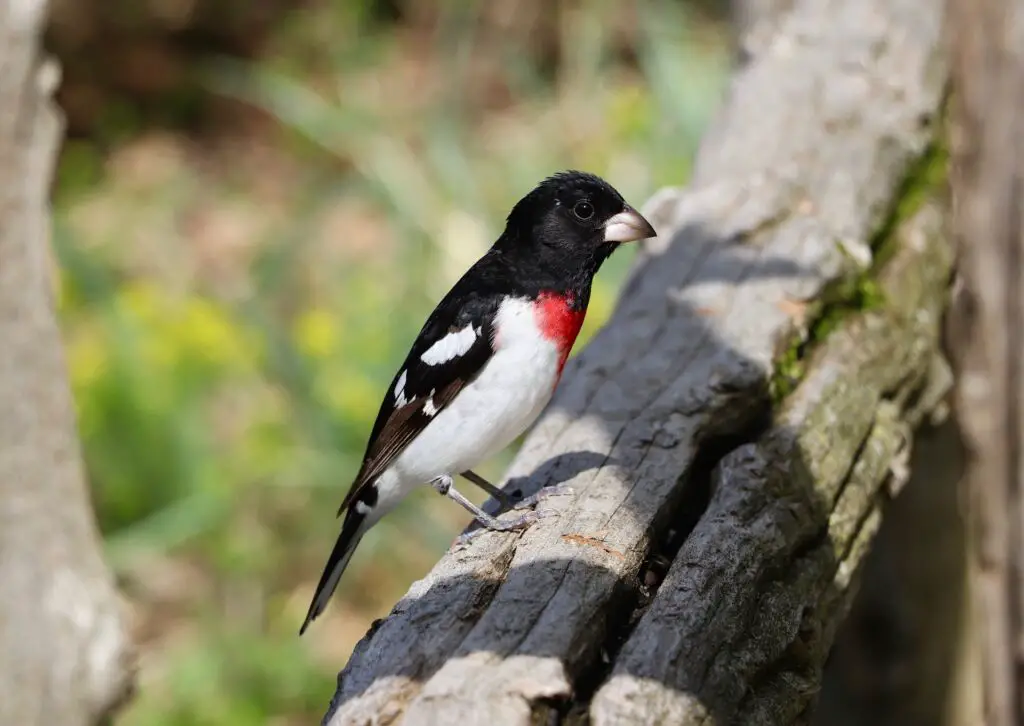
The first time I saw a grosbeak- a male rose-breasted grosbeak- I knew nothing about them!
I was so excited to learn more about these uncommon birds that live all around us that I gathered up a bunch of facts to get to know them better and help me ID them.
What does grosbeak mean?
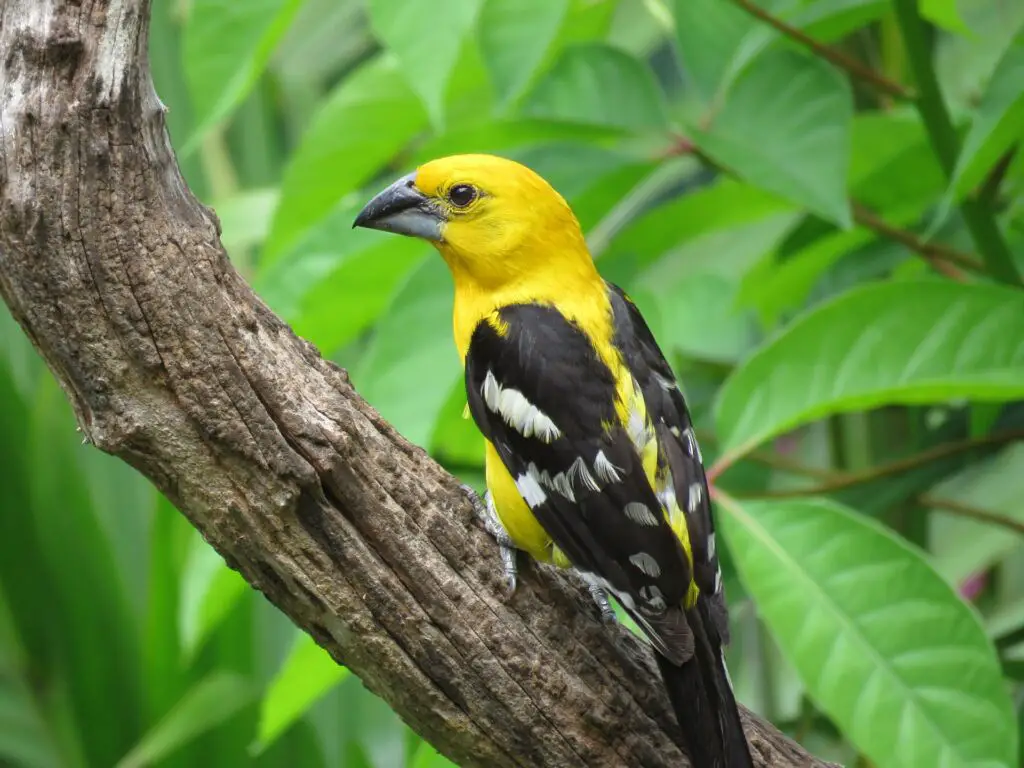
The name grosbeak comes from the French grosbec, which means large beak
How many different types of grosbeaks are there?
There are about 35 different species of grosbeaks. Some are classified as finches, others as cardinals, some as tanagers and one as a weaver.
Some types, like the Somali, Arabian, and Socotra golden-winged grosbeaks might actually be one species.
Grosbeaks belong to the Passerine, or passeriformes order. Sometimes these types of birds are called songbirds or perching birds
- Grosbeaks in the cardinal family
- Mexican yellow grosbeak
- Southern yellow grosbeak
- Black-thighed grosbeak (Costa Rica and Panama)
- Black-backed grosbeak
- Rose-breasted grosbeak
- Black-headed grosbeak
- Red-and-black grosbeak (northern South America)
- Black-faced grosbeak
- Yellow-green grosbeak
- Crimson-collared grosbeak, (eastern Mexico)
- Ultramarine grosbeak
- Blue-black grosbeak
- Glaucous-blue grosbeak (eastern South America)
- Blue grosbeak
- Grosbeaks in the finch family
- Evening grosbeak (North America)
- Hooded grosbeak (Mexico)
- Japanese grosbeak (Japan, eastern China)
- Chinese grosbeak
- Black and yellow grosbeak (southern Asia)
- Collared grosbeak (southern Asia)
- Spot-winged grosbeak (southern Asia)
- White-winged grosbeak (southern Asia)
- Pine grosbeak (North America, Siberia)
- Somali golden-winged grosbeak (Somalia)
- Arabian golden-winged grosbeak
- Socotra golden-winged grosbeak
- São Tomé grosbeak (western Africa)
- Northern grosbeak-canary
- Southern grosbeak-canary
- Bonin grosbeak (extinct)
- Kona grosbeak or grosbeak finch (extinct, Hawaii)
- Tanager Grosbeaks
- Slate-coloured grosbeak
- Black-throated grosbeak
- Yellow-shouldered grosbeak (South America)
- Grosbeaks in the weaver family
- Thick-billed weaver
What does a grosbeak eat?
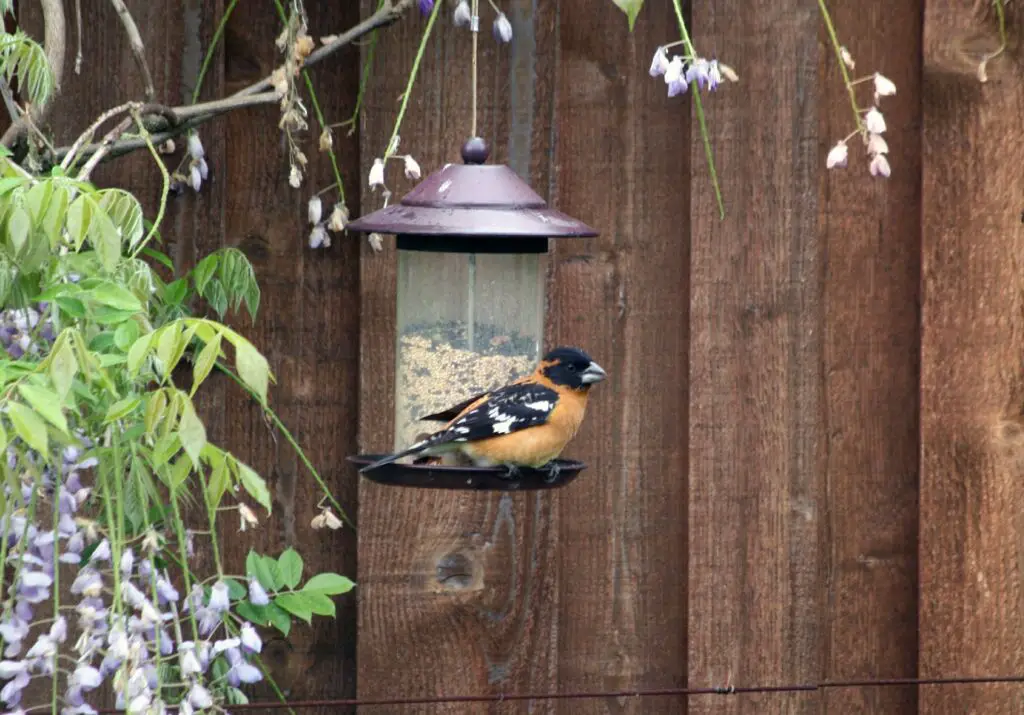
Although different grosbeak species are found all around the globe, they all eat seeds!
Do grosbeaks mate for life?
No, most grosbeaks do not mate for life.
They keep the same mate for one brooding season and then choose a new mate the next season.
How long does a grosbeak live?
The average wild grosbeak lives approximately 7 years in the wild.
However, one captive rose-breasted grosbeak lived for 24 years!
Are grosbeaks aggressive?
No, grosbeaks are not aggressive.
However, they may act aggressively towards intruders near their nests.
How many broods do grosbeaks have?
Grosbeaks typically have one brood per year. However, they occasionally have two broods per year.
Evening Grosbeak facts
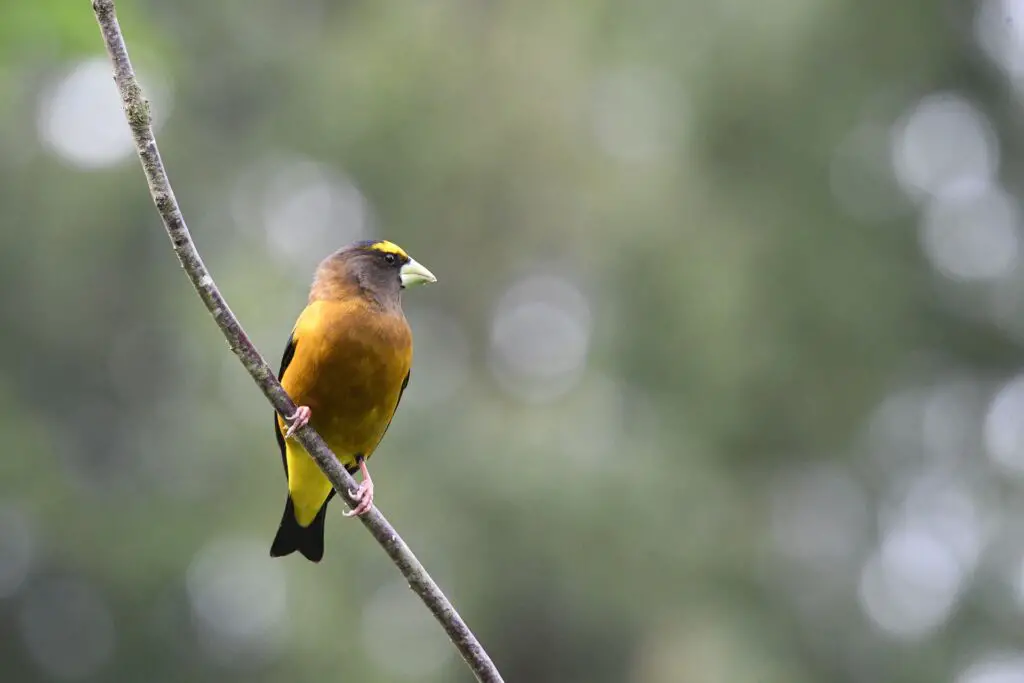
- Males have yellow foreheads and bodies, while females are olive brown
- Evening grosbeaks mainly eat berries, seeds, and insects
- They primarily live in southern Canada and the northern US
How did the evening grosbeak get its name?
When scientists first discovered the evening grosbeak, they only heard it singing at dusk, so they naturally named it the evening grosbeak. However, within a few years, they realized this bird actually sang all day. But the name had already been documented and it stuck!
Read a more detailed account at The Audubon Society
Even the evening grosbeak’s scientific name, Hesperiphona vespertina, still means evening cry
Rose-breasted grosbeak facts
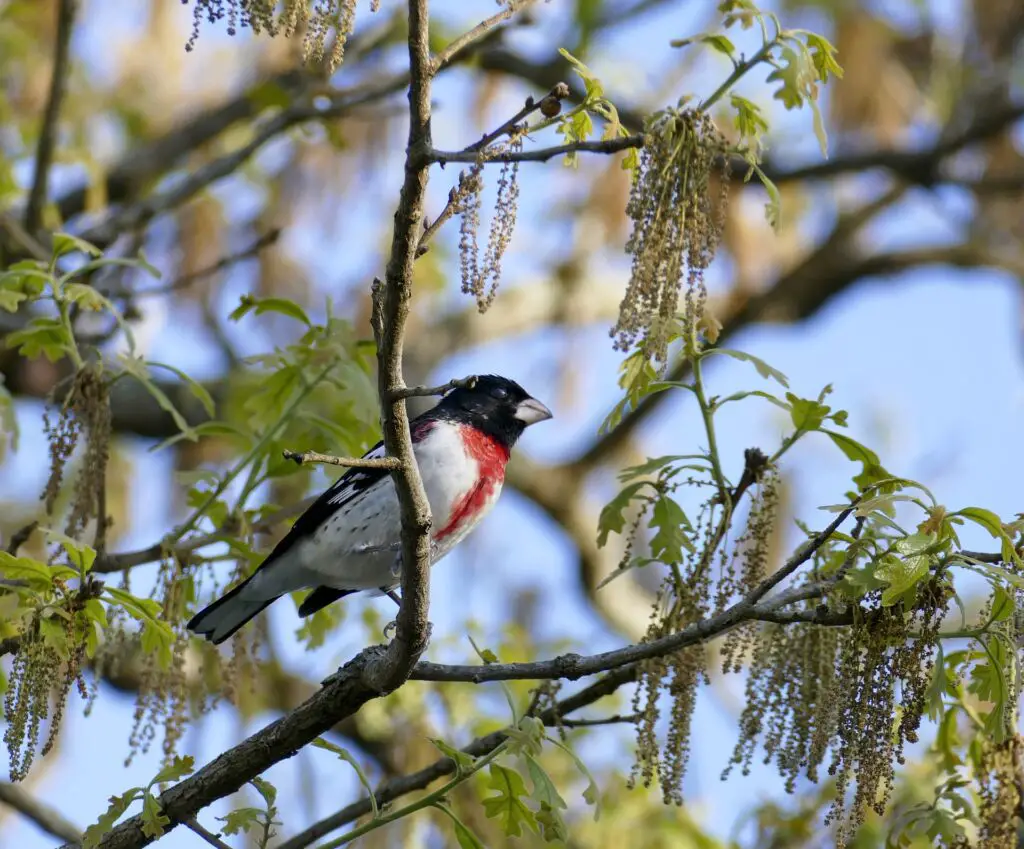
- The average wild rose-breasted grosbeak lives for 7 years. They can live up to 24 years in captivity.
- Rose breasted grosbeaks live east of the Rocky Mountains in the northeastern United States and Canada
- Some birds migrate to Mexico and Central America for the winter
- The latin name for the rose-breasted grosbeak is Pheucticus ludovicianus. This roughly translates to shy bird feom Louisiana, which is where they were first documented
- Some people call these birds cutthroat due to their coloration
- Male and female red-breasted grosbeaks look very different. This phenomenon is called sexual dimorphism
- Rose-breasted grosbeaks prefer to nest in open deciduous forests
- They normally lay 3-4 pale blue eggs with red-brown spots. But they may lay anywhere from 1-5 eggs!
- Rosebreasted grosbeaks primarily eat seeds, insects and berries. But they’ve been known to drink nectar occasionally too!
- Rose breasted grosbeaks can mate and hybridize with black-headed grosbeaks
Black-headed grosbeak facts
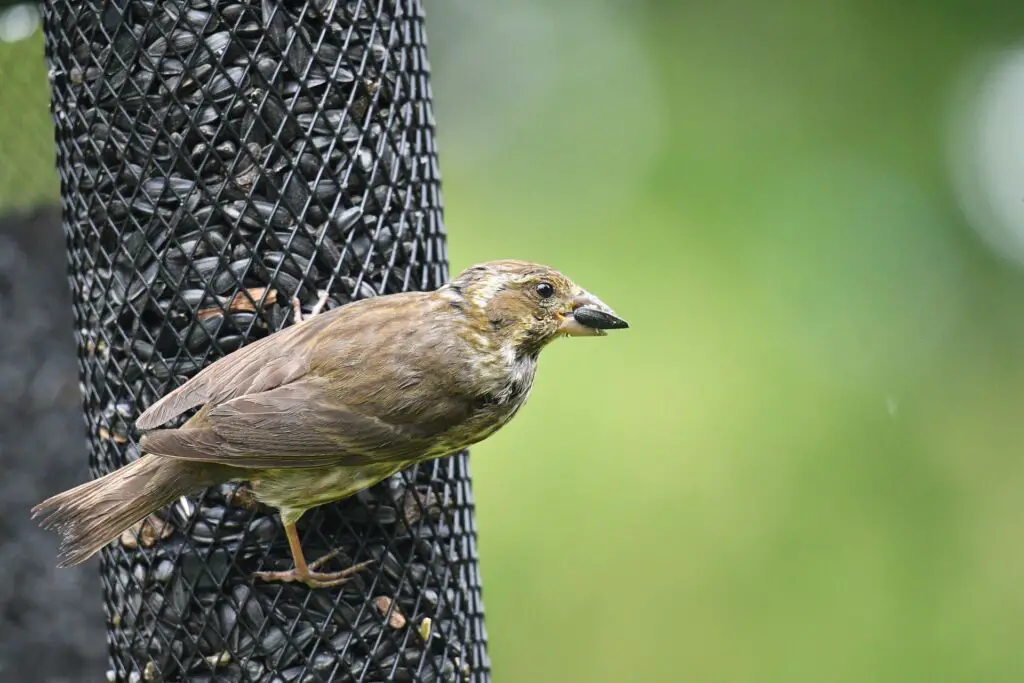
- The black-headed grosbeak is closely related to the northern cardinal
- Black-headed grosbeaks typically live west of the Rocky Mountains in the United States. However, some also live in the Great Plains in Texas, Oklahoma, Nebraska and the Dakotas
- These birds prefer to live in forests with large trees and lots of bushes, especially alongside rivers, streams, lakes, and wetlands.
- Females lay 2-5 blue-green eggs spotted with red
- A pair of grosbeaks are monogamous for one breeding season, but tend to find a new partner the following year
- Like rose-breasted grosbeaks, black-headed grosbeaks eat seeds, insects, berries and fruit. They even eat spiders and snails. And they can eat monarch butterflies, which are poisonous to most types of birds!
Pine grosbeak facts
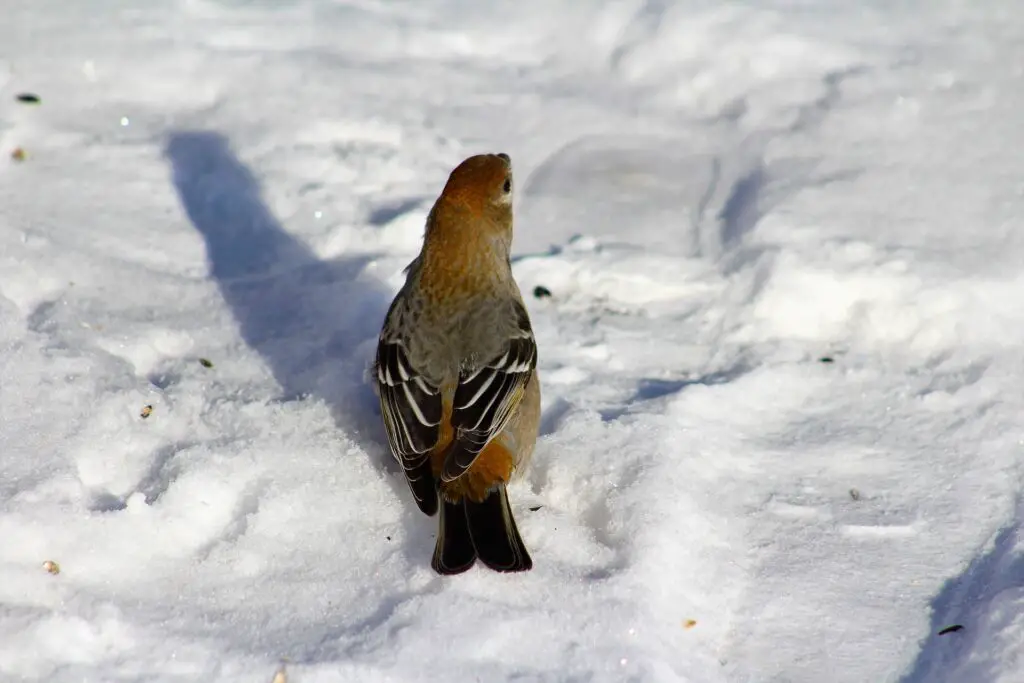
- Pine grosbeaks mainly eat the fruit from ash trees, but also eat seeds and insects
- There are 8 different sub-species living in North America, Siberia, Japan
- As their name suggests, pine grosbeaks nest in coniferous trees
- Adult pine grosbeaks have forked tails
- Their white eggs have brown speckles
Blue Grosbeak Facts
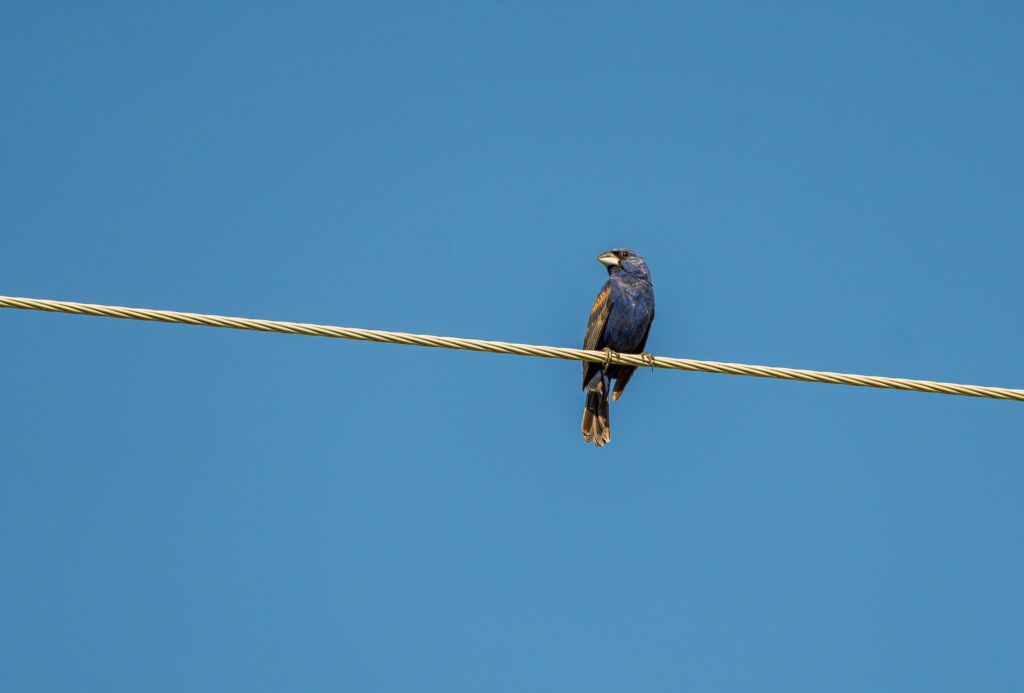
- Blue grosbeaks are part of the Cardinal family, which includes the Northern Cardinal.
- The blue grosbeak’s scientific name is Passerina caerulea, which roughly translates to sky-blue sparrow-like bird
- There are 7 different sub-species of blue grosbeaks that live in different parts of the US, Mexico, and Central America.
- Blue grosbeaks prefer to live in open habitats with scattered trees and bushes, such as thickets, overgrown fields and the edges of woodlands
- These birds typically eat seeds, insects (including small spiders), and wild fruit
More grosbeak facts
- All grosbeaks have 3 toes pointing forward and one toe pointing back to help them patch
- Grosbeaks all have 12 tailfeathers
Grosbeak Identification
It’s easy to confuse grosbeaks with other types of birds, especially finches. But we will walk through some easy ways to tell all these birds apart!
Grosbeak vs Oriole
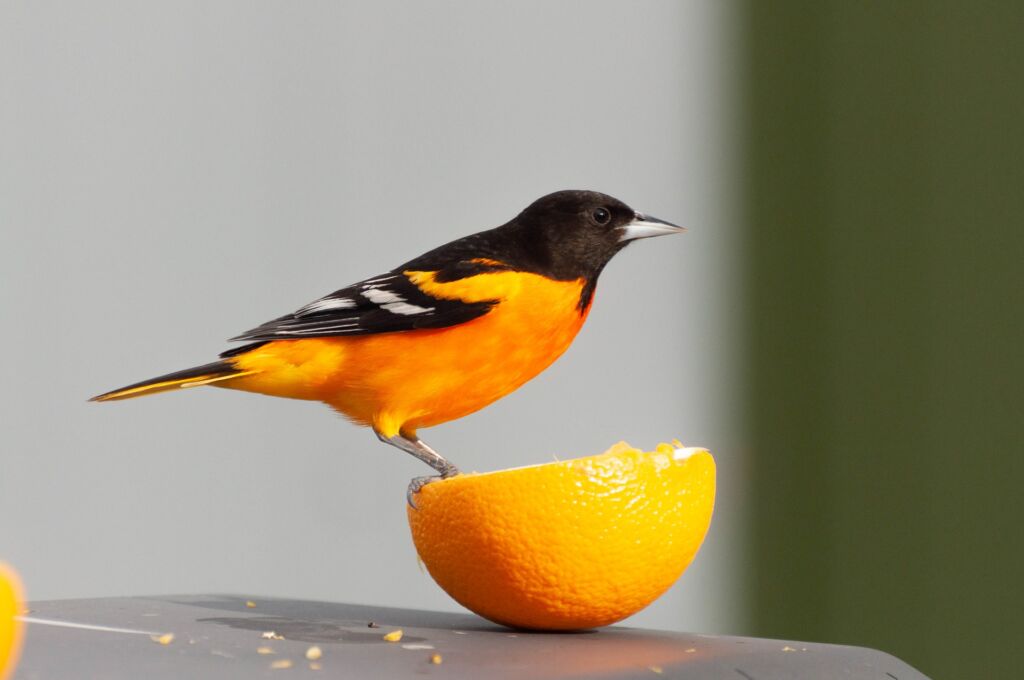
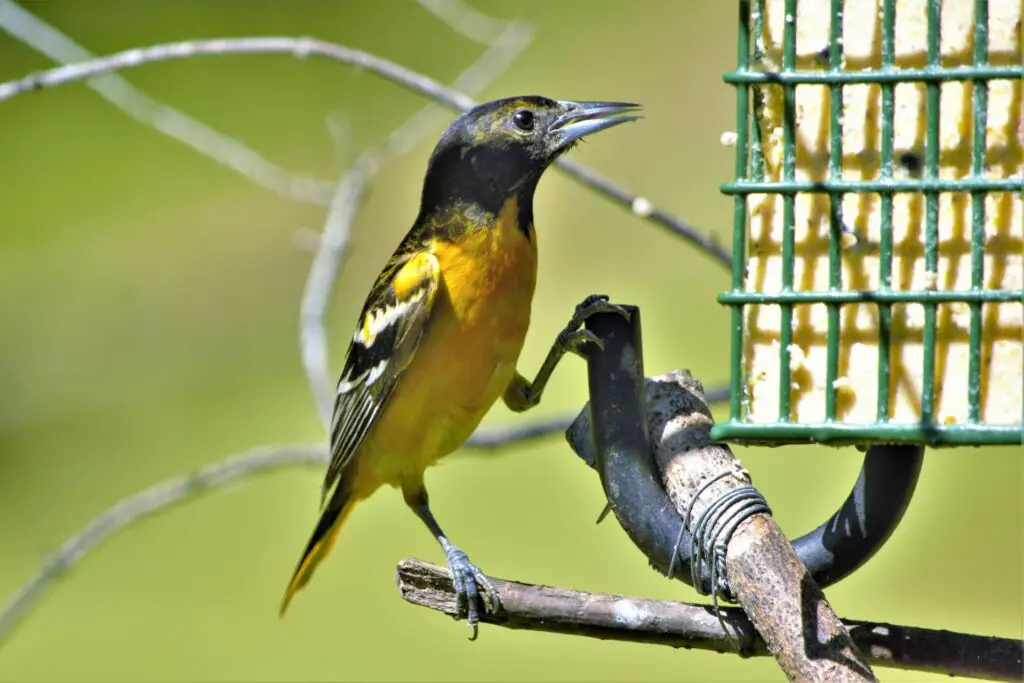
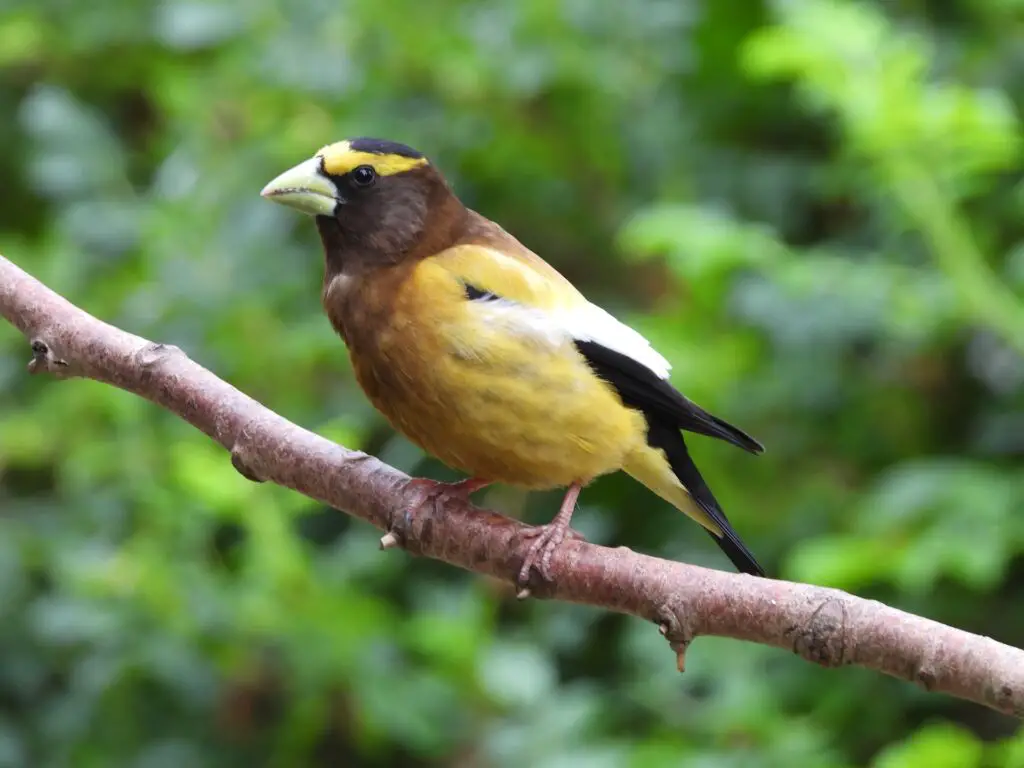
When comparing grosbeaks vs orioles, the easiest way to tell them apart is their beaks. Orioles have longer, slightly curved beaks. And grosbeaks have shorter, thicker beaks.
There are other clues when you compare an oriole vs an evening grosbeak. Grosbeaks have a yellow-orange stripe across their faces while orioles heads are completely black.

Black headed grosbeaks also eat jelly at oriole feeders, which can be even more confusing! Black-headed grosbeaks also have thick, bulky beaks vs the oriole’s slimmer beak.
Female orioles are yellowish, vs female black headed grosbeaks and evening grosbeaks, which are primarily brown.
Orioles tend to live east of the Rocky Mountains, while black-headed grosbeaks live from the Great Plains westward. So if you live in the eastern US, it’s probably an oriole!
You can also see more black-headed grosbeak pictures at Allaboutbirds.com
Are grosbeaks and orioles related?
Grosbeaks and orioles are somewhat related.
Orioles and grosbeaks are both in the Passeriformes order. However, orioles are in the icteridae, or New World Blackbird family, which includes grackles, cowbirds, meadowlarks, and red-winged blackbirds.
And grosbeaks are in several families.
The pine grosbeak and evening grosbeak are in the finch family, Fringillidae. And rose-breasted grosbeaks are in Cardinalidae, the cardinal family.
Grosbeak vs Finch
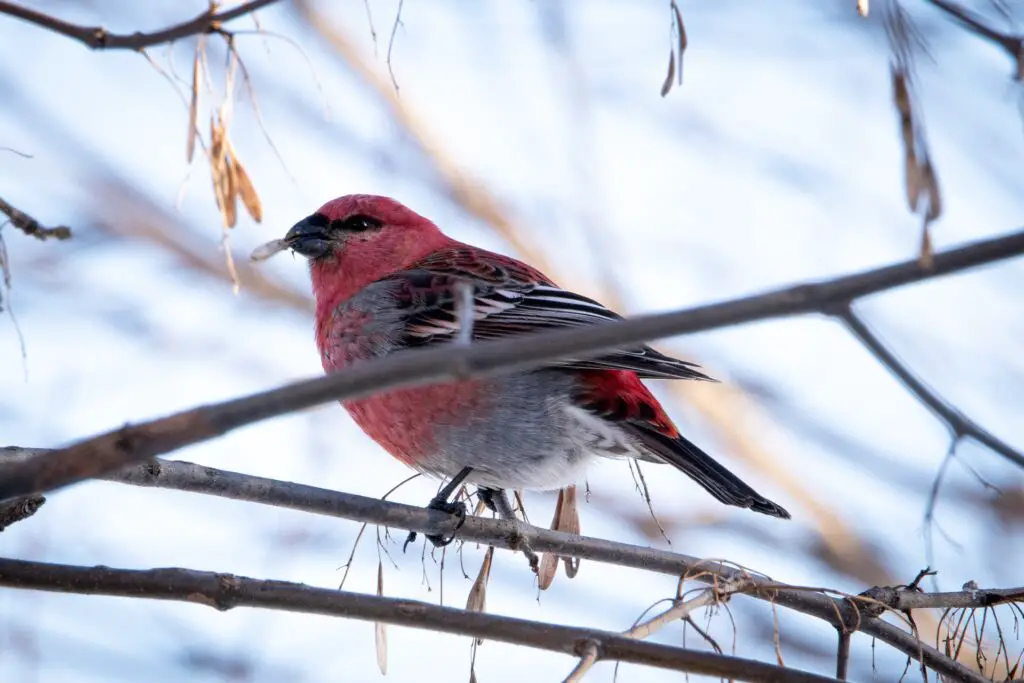
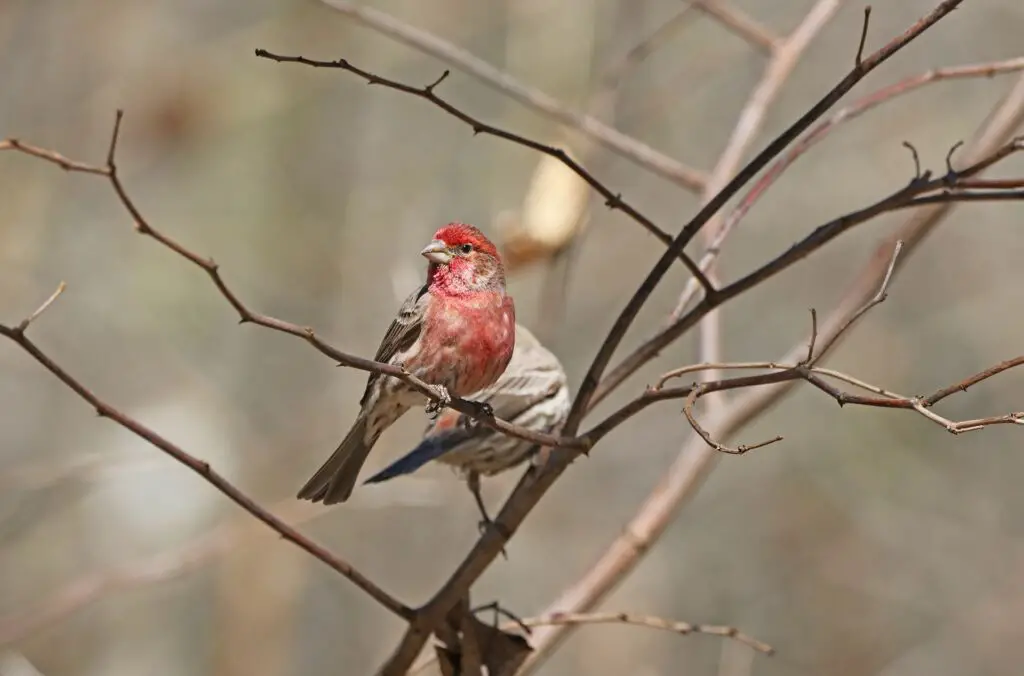
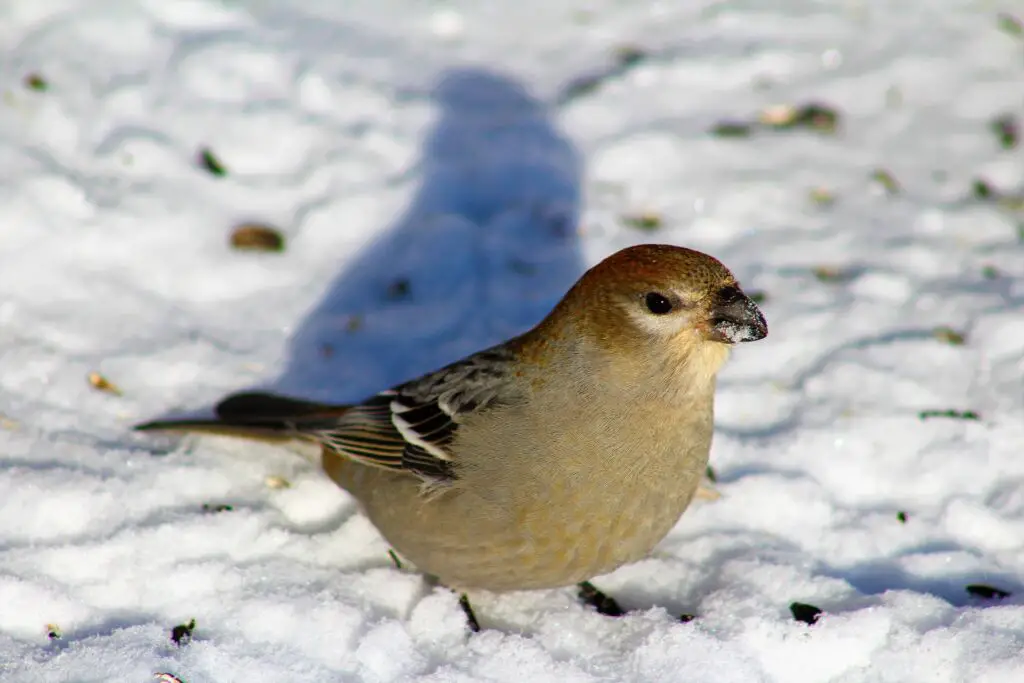
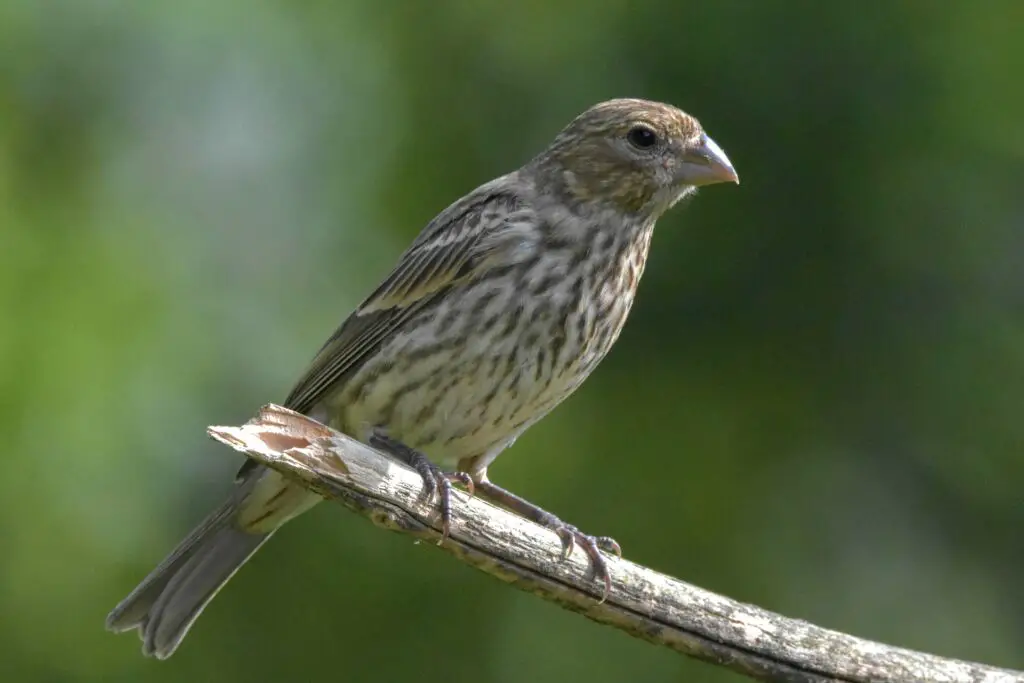
When identifying a pine grosbeak vs a purple finch or house finch, it’s difficult to distinguish these birds based on their coloration.
You may also be comparing a female rose-breasted grosbeak vs a female finch, which are both streaky white and brown. Luckily, these tips will help you identify these different birds.
- All grosbeaks have large, thick beaks vs a finch’s conical beak
- Rose-breasted grosbeaks and pine grosbeaks are larger than purple finches and house finches. They’re about the size of a robin.
- Female rose-breasted grosbeaks have a pinkish beak compared to finches, which have gray beaks
- Female finches have thicker streaks on their belly compared to female rose-breasted grosbeaks. And the grosbeaks have whiter bellies than the finches
Grosbeak vs Goldfinch
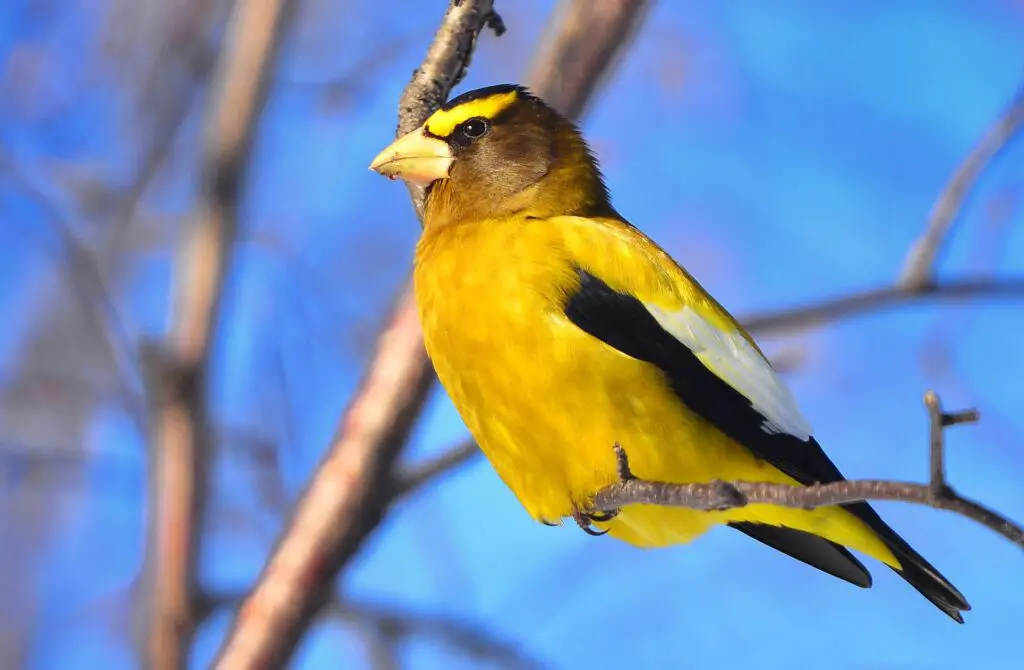
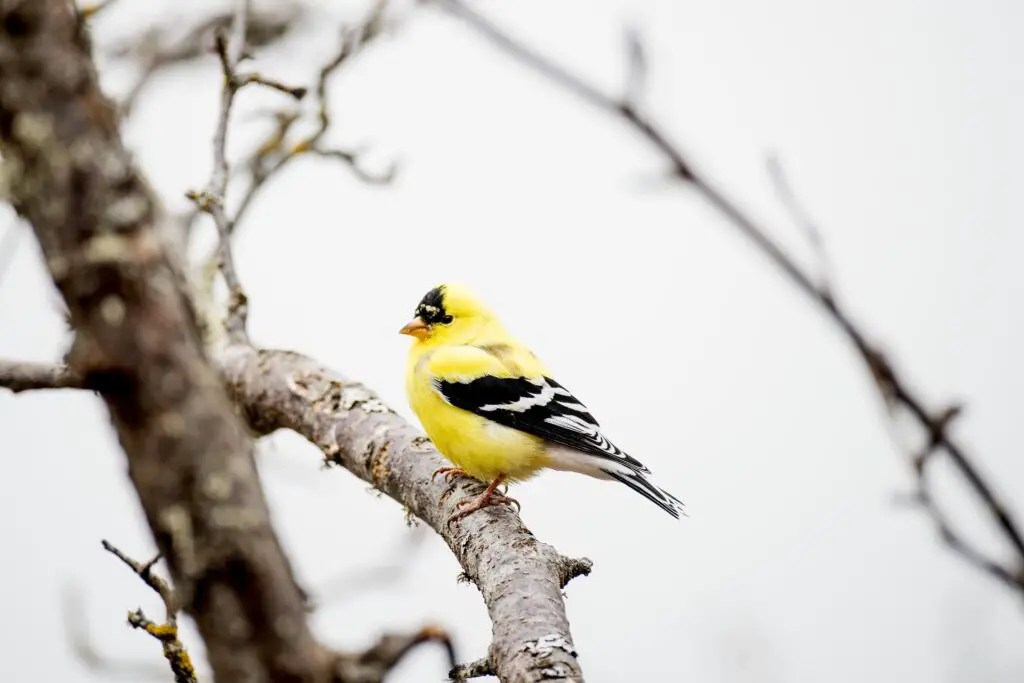
Identifying evening grosbeaks vs goldfinches is challenging.
- Goldfinches are much smaller vs the mourning-dove sized evening grosbeak
- Male goldfinches have yellow heads with black patches from their bills to the top of their heads. Evening grosbeaks have black heads with a yellow stripe above their eyes
- Male evening grosbeaks have a large white patch on their wings, versus a male goldfinch’s white-tipped wing feathers
Is a grosbeak a finch?
Yes, the pine grosbeak and evening grosbeak are part of the finch family, Fringillidae.
This family also includes goldfinches, house finches, and purple finches.
Grosbeak vs Towhee
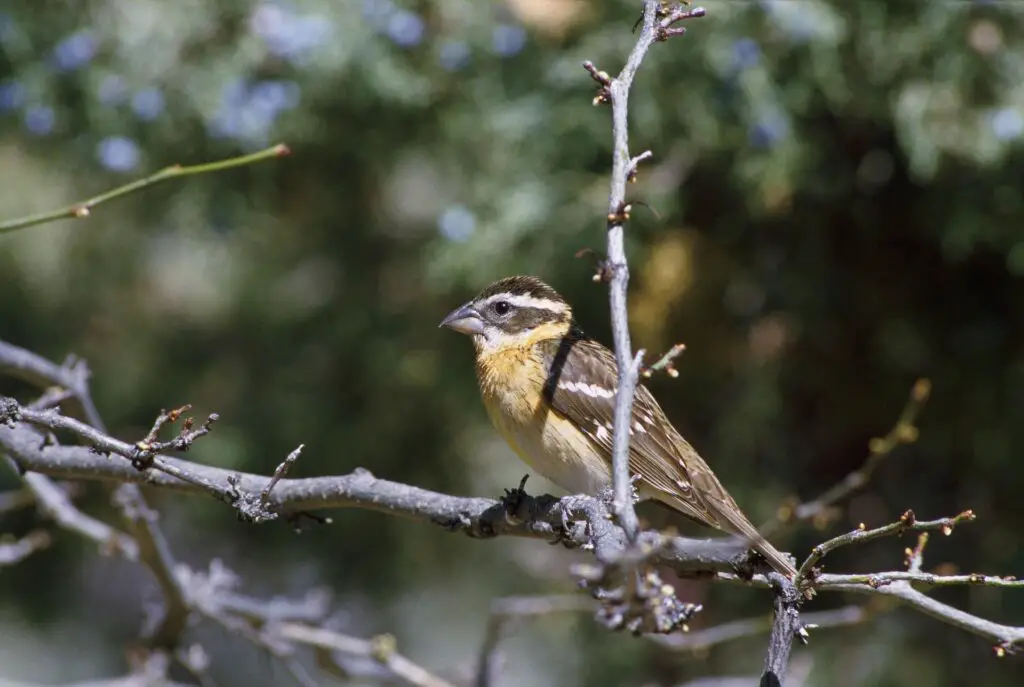
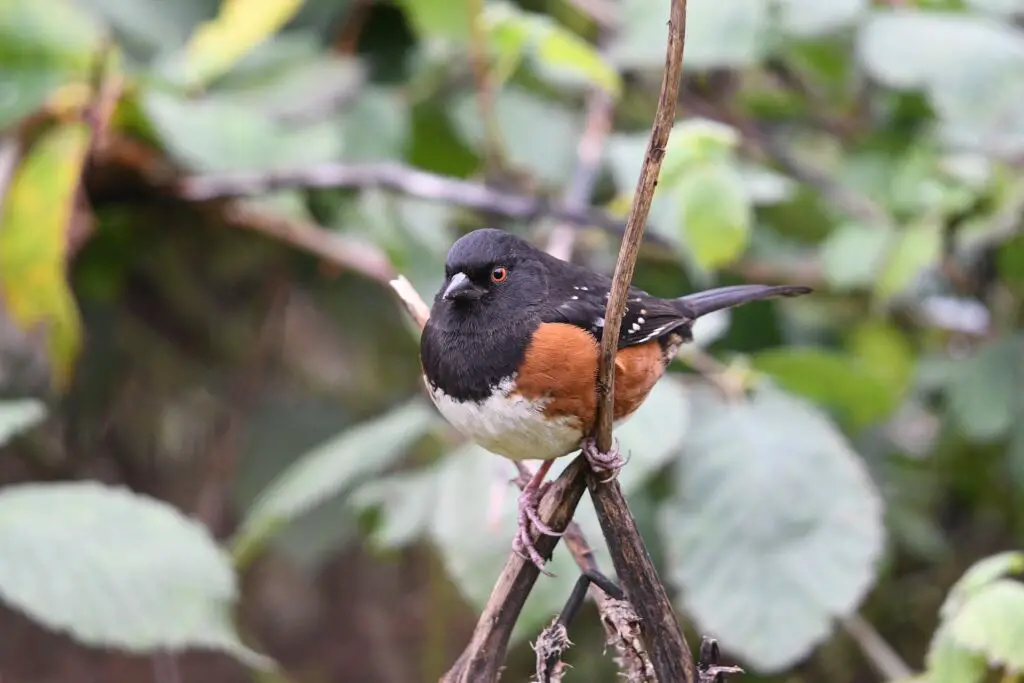
The male spotted towhee vs the black-headed grosbeak can be a common identification challenge for birders.
Although the coloration of the grosbeak vs towhee are similar, here are some more reliable ways to tell the two birds apart.
- The black-headed grosbeak has a thick bill, compared to the narrow bill of the towhee
- Grosbeaks are large, about the size of a robin, versus the sparrow-sized towhee
- Towhees often forage for food on the ground, while grosbeaks are usually found in trees
- Spotted towhees have longer tails than black-headed grosbeaks
- And spotted towhees have a white patch on their bellies, while a grosbeak’s belly is completely orange
Grosbeak vs Indigo Bunting

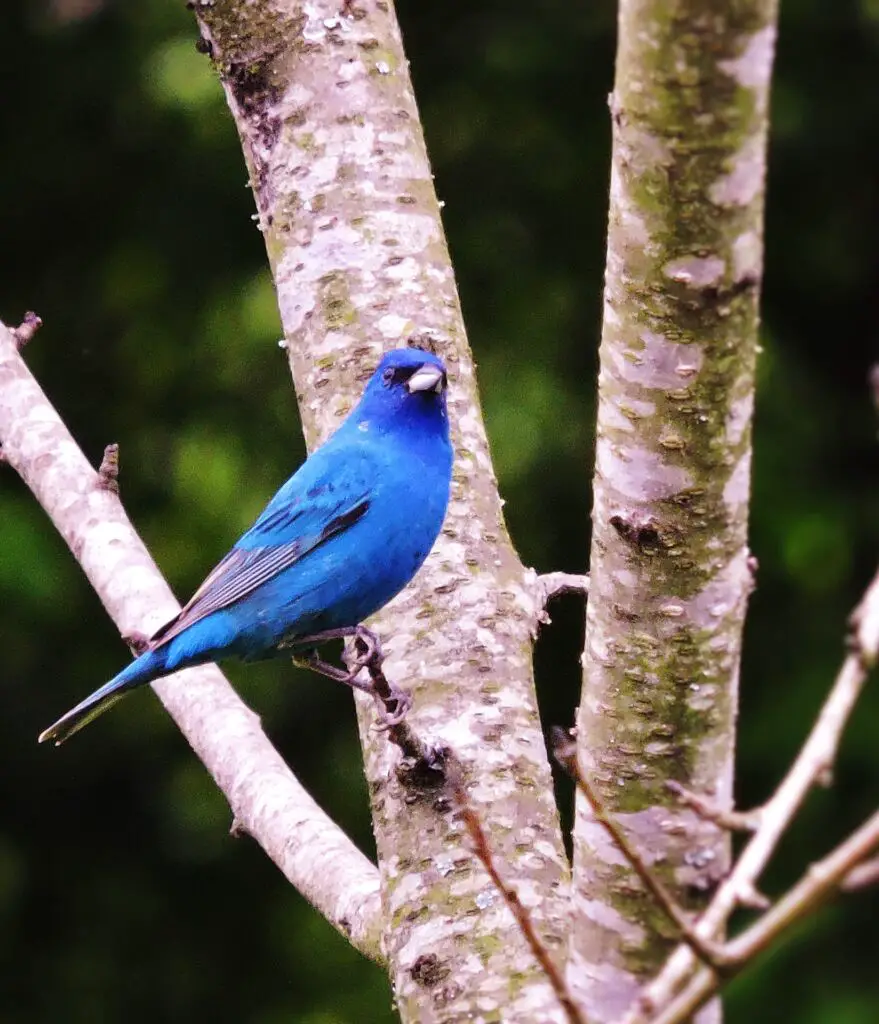
Comparing the blue grosbeak vs the indigo bunting is confusing. Both have blue bodies with dark wings and tails. Here are a few tips to differentiate the grosbeak and indigo bunting:
- The blue grosbeak has a thick beak, vs the conical break of the indigo bunting
- Indigo buntings (the size of sparrows) are smaller than grosbeaks (the size of robins)
- Male blue grosbeaks have brown wing bars while male indigo buntings have dark colored wings overall
- Finally, some tips for identifying female birds: grosbeaks are rich brown while buntings are more dull brown. The grosbeak has dark wing bars, while the bunting’s wings are almost all dark brown
Blackheaded Grosbeak vs Robin

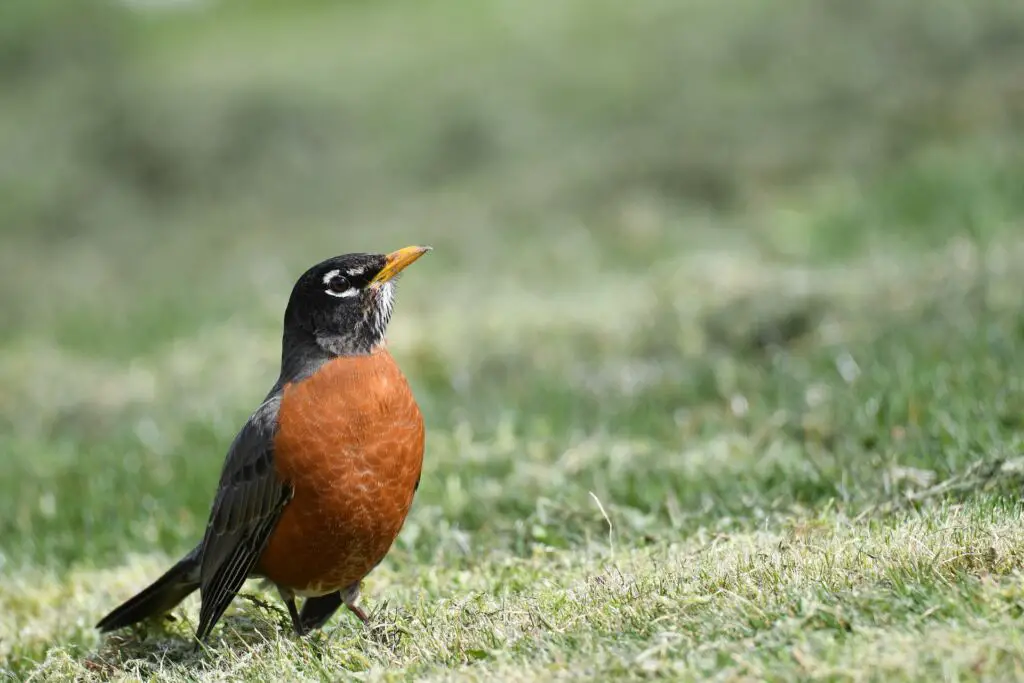
Identifying a black headed grosbeak vs a robin can be tricky based on appearance alone, since both birds are brown with orange bellies.
But here are some simple tips to help you identify a grosbeak vs a robin:
- Robins often hop around on the ground while foraging for bugs, while grosbeaks are usually found in trees or bushes. If a grosbeak is foraging on the ground, it’s likely in dense foliage
- Robins do not eat at bird feeders, but grosbeaks will visit to eat sunflower seeds
- Grosbeaks have thick, chunky beaks. Robins have thinner beaks.
- The grosbeak has a white stripe over its eye and on its wing, while a robin does not
- Both birds are about the same size
Identifying black headed grosbeak vs robin by their songs
Identifying a blackheaded grosbeak vs a robin through their songs is challenging! Their songs sound similar but have some differences you’ll be able to make out if you listen carefully
- Both have rich warbling songs
- The robin’s song is often described as sounding like “cheerily, cheer up, cheer up, cheerily, cheer up.”
- And the notes in the black headed warbler’s song are much faster. To me, they sound more like chrrrip, vs the robin’s “cheer up.”
Blackheaded grosbeak vs female rose-breasted grosbeak


Identifying a female black headed grosbeak vs a rose- breasted grosbeak is straightforward once you know what to look for
- Female black headed grosbeaks have orange on their breasts vs rose- breasted grosbeaks, which do not
- The streaks on a black headed grosbeak’s head are more yellow while the rose breasted is more white
- Other than these clues, both birds look very similar, they are primarily brown with white undersides streaked with brown
Cornell’s All About Birds has excellent pictures comparing female black headed grosbeaks vs rose breasted grosbeaks!
Grosbeak facts and identification wrap up
Here’s one last grosbeak fact: you can find them all over the world! Identifying grosbeaks vs other birds is easy if you get a good look at the grosbeak’s thick beak.
And you may even see one at your bird feeder!
